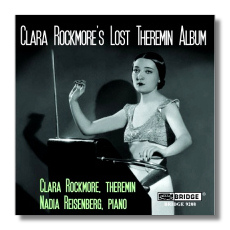
The Internet's Premier Classical Music Source
Related Links
- Latest Reviews
- More Reviews
-
By Composer
-
Collections
DVD & Blu-ray
Books
Concert Reviews
Articles/Interviews
Software
Audio
Search Amazon
Recommended Links
Site News
 CD Review
CD Review
Clara Rockmore's Lost Theremin Album

- Fritz Kreisler:
- Liebesleid
- Midnight Bells
- Johann Mattheson: Air in B minor
- Antonín Dvořák: Humoresque in F Sharp Major, B 138
- Anis Fuleihan: Concerto for Theremin – Pastorale 1
- Franz Schubert: Ave Maria (Ellens Gesang III, D 839/Op. 52 #6)
- Frédéric Chopin: Nocturne in C Sharp minor, Op. posth.
- Gaspar Cassadó: Requiebros
- Johann Sebastian Bach:
- Concerto for Harpsichord in D minor, BWV 1052 - Adagio
- Celebrated Air (Air for the G String)
- Heitor Villa-Lôbos: Bachianas Brasileiras #5: Aria 1
- Richard Heuberger (arr. Kreisler): Midnight Bells
- Maurice Ravel: Mélodies hébraïques #1 "Kaddish"
- George Gershwin: Summertime
- Avery Robinson: Water Boy
- Manuel Ponce: Estrellita 2
- Louis Louiguy: La Vie en rose
Clara Rockmore, theremin
Nadia Reisenberg, piano
1 Cello Ensemble
2 Jorge Morel, guitar
Bridge 9208
Many collectors treasure "The Art of the Theremin," an album on the Delos label, issued on LP and then on CD (Delos DE1014). Recorded in 1975, it featured the artistry of Clara Rockmore accompanied by her sister, pianist Nadia Reisenberg. Clara's first instrument was the violin, but after she came to the United States in 1927, she became acquainted with Leon Theremin and with the early electronic instrument that bears his name. Fascinated, she became the instrument's most prominent exponent, achieving a level of celebrity that allowed her to share a concert stage with both Leopold Stokowski and Paul Robeson.
The theremin is played without touching it. It has a vertical rod antenna governing pitch and a horizontal tubular antenna governing volume. To control pitch and volume, the thereminist moves her hands toward and away from the two antennas. I have never seen a thereminist in action, but I wager that watching him or her perform on this instrument must look as beautiful as the sounds that are created. In its highest registers, it sounds both like a soprano and a violin. In its lower registers, the tone is throatier and more obviously "electronic," but not less beautiful. A skilled player – and Rockmore certainly was one – can negotiate complicated passages, even with staccato articulation, by twisting and turning her fingers, hands, and wrists with the utmost precision.
There are 12 selections on "The Art of the Theremin," each one beautiful and impressive in its own way. What most people are unaware of (including myself, until now) is that Rockmore and Reisenberg recorded 16 more items during the same sessions (which were presided over by electronic music pioneer Robert Moog). These were not released, however, and they were referred to by Rockmore herself as her "lost album." In 1989, Robert Sherman, Reisenberg's son, released a compilation devoted to his mother, and included three of the 16. Now all 16 have been released on this one CD. For the three that were released in 1989, Sherman has "felt free to refresh these performances" by adding cellos or a guitar, as indicated in the above headnote. (Bridge's booklet credits Sherman as "Participating Nuisance" – tongue in cheek, one assumes!)
And so, we have "Clara Rockmore's Lost Theremin Album," which is just as enjoyable as "The Art of the Theremin." Most of the selections are arrangements, of course, with the sole exception (I think) of Anis Fuleihan's Pastorale. If anything, this new CD gives an even more complete picture of the theremin, and of Rockmore's artistry, than the Delos release. Try, for example, the start of Mattheson's Air, in which we hear the instrument's lowest tones – about two octaves below middle C. (On the other end, it can reach more than two octaves above middle C, to yield a total range of about five octaves.) The music that has been chosen suits the instrument beautifully. Granted, there is a shortage of fast music, which even in hands as agile and precise as Rockmore's can sound a little awkward on the theremin, but no matter. The use of the cello ensemble in the Villa-Lôbos, as specified by composer, really works. (Villa-Lôbos wanted sopranos who sang this work to sound like a violin, and I can't help feeling that the theremin's tone is exactly what he had in mind.) Reisenberg's accompaniments are delivered with suavity and sisterly understanding. As for the recording, despite its age and analogue origin, no allowances need to be made. The booklet contains, in addition to Sherman's note and several photos, a transcribed conversation between Rockmore, Reisenberg, and Moog.
One might want to dismiss this CD as kitsch, or as a soundtrack for a science fiction movie that never got made. However, if you give it a chance to cast its unearthly spell, I predict that you'll come back to it again and again, with your admiration and respect increasing each time.
Copyright © 2007, Raymond Tuttle





















